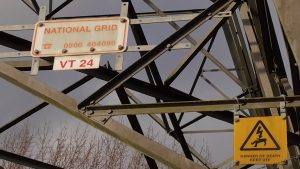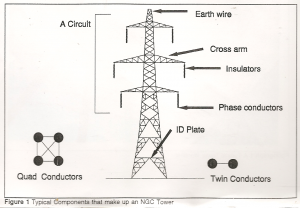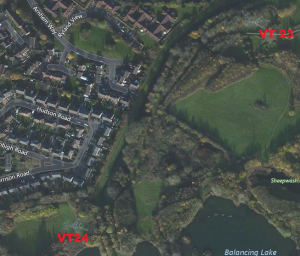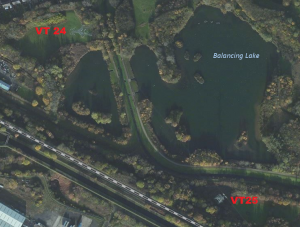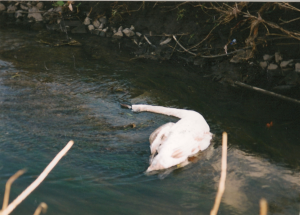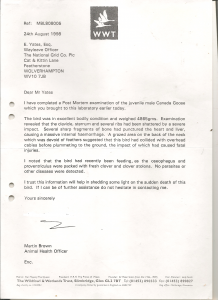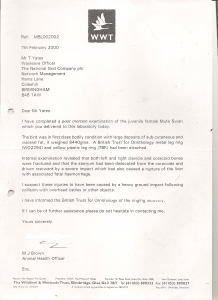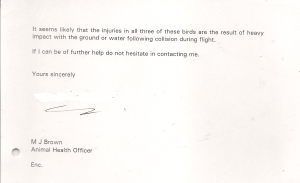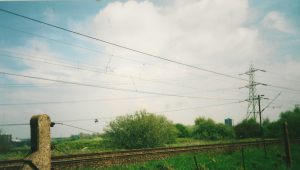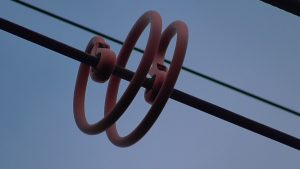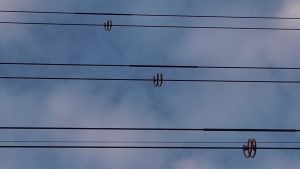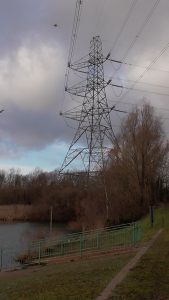Overhead power lines are ghastly things. To wildfowl they are snares in the sky- particularly perilous when they cross nature reserves and bodies of open water that entice the wild birds to gather there, as is the case unfortunately at Sheepwash.
My experience of power lines and birds started quite by accident when I saw a swan collide with them in 1997. But for that I would probably never have become interested or involved in bird rescue or any other animal related activities- and there are some people that would wish that had happened. 😆
I knew this female swan by ring number- LBV and she had been nesting with her mate on a nearby canal. The worst thing about the collision was the horrendous snapping noise of the collision- amplified by a rising shhhhhhh sound of generation. But because of the landing she was still alive and had splashed into the water falling several metres.
Unfortunately it was three days before I found any contact details for any rescue organisation and by this time on rescue the injuries were too severe and the swan died.
It would turn out to be the first of many such similar events and the start of trying to get something done to stop it.
Firstly I need to explain about power lines and “towers” as those in the industry refer to them- electric pylons to the layman.
The National Grid Company control the major towers in the UK- and they own the ones that cross Sheepwash. At the top of each tower runs the single conductor wire known as “the earthwire”. Underneath this are three arms on each side known as cross arms. These arms support three sets of conductors making up the circuit. Insulators hang from the cross arms and are circular.
Running from the conductors are the phase conductors– three lines referred to as bottom , middle and top phase conductors. The diagram below explains this set up, and if you look up at your nearest set of power lines you can identify the terms referred to here. Two types of National Grid tower “suspension towers” and “tension towers” exist- A suspension tower has the insulators hanging vertically whereas a tension tower will have the insulators hanging horizontally from the cross arm.
The other factor in this post is the importance of the location of the incidents at Sheepwash. There are three pylons that cross the reserve, and all three spans have produced collisions for the birds.
Sheepwash was created as a nature reserve in the early 1980’s from a former refuse tip. This tip had a water feature, and along side it ran the River Tame. The power lines and the positions of the towers at this point were well established. Unfortunately there wasn’t much thought in that the power lines crossed two of the created pools- so basically wildfowl attracted to the site- especially flying from the South in a North West direction would be faced with a ghastly hazard on attempting to land. The choice being either go over the power lines- i.e the top earthwire and curve around to land, or attempt to fly underneath them- the bottom phase conductor.
Added to this menace is the central position of VT24- known as an “angle tower” on account that it links two spans of powerlines together. So two whole sides of the main lake at Sheepwash are surrounded by these two spans hanging from the two towers. A third span connects from another tower (VT 25) across the Birmingham mainline canal and the West Coast railway line between Birmingham and Wolverhampton. This produces a further hazard in that the train electrified lines create another obstacle which force the birds to fly upward on route towards the national grid lines.
The powerline carnage continued at the site and it was a short time later that I made contact with the National grid, coming across their wayleave officer Ted Yates. It was clear that national grid wanted “evidence” of collisions, and I had also seen some articles on bird diverters being fitted and so began this campaign.
Dead birds were collected that had hit or were suspected to have hit powerlines. Ted Yates then arranged for them to be taken to the WWT at Slimbridge for independent post mortem.
It was also the case that some birds had horrific wing breaks but had survived the fall by landing in the water- as I had witnessed myself. It was clear that birds could survive the impact of the collision, but if they fell to ground or landed on the islands they would die from associated “ground impact” injuries. The post mortems mainly conducted by highly experienced and published avian vet Martin Brown confirmed many of these ground impact injuries associated with overhead collision. Typical injuries were broken ribs, clavicle and sternum with bone fragments puncturing the heart and liver of falling birds causing massive haemorrhage.
Below are some examples of post mortems carried out, and the picture which began to emerge.
The highest number of known casualties appeared to be swans, though Canada geese and pigeons were also victims of the metal wires. Some were inexperienced juveniles, but others were adult birds. Wind conditions were no doubt a factor, but collisions occurred throughout the year- apart from the main moulting period when the birds were flightless. October would always be a worrying time however when they started to fly again. Some birds collided flying alone, but others collided flying in groups. It was apparent that group flyers in formation may panic when another bird saw the lines and took evasive action, but those flying behind were too late and unable to take a similar course.
Eventually Ted Yates and others in the company managed to get the high ups in National Grid to fit diverters on the bottom phase conductor on one side of the span crossing the main lake. The picture below shows the cable car used by National Grid crossing the power lines and fitting the bird diverters to this span. It was stated that the top earthwire was unable to be fitted with diverters for technical reasons.
The diverters themselves were bright orange steering wheel sized disks. In all twelve were evenly spaced across the lengthy span.
A few years later and with a reduced number of collisions, National Grid were undertaking major works along the network which included the complete rebuild of tower VT 25 on Sheepwash. The opportunity was taken to fit additional diverters on the middle and top phase conductors on the same side as those already there. This would obviously provide additional surveillance for the birds and make the lines stand out more in darker conditions.
In 2020, more additional diverters were added to the span between the angle tower and the tower nearest to Sheepwash Lane on the one side thanks to pressure from The Friends of Sheepwash/Swanwatch and Sandwell council. More additional diverters are due to be fitted on the opposite phase in 2021.
Monitoring at sheepwash has continued , and though the rate of collisions has decreased, they still occur.

